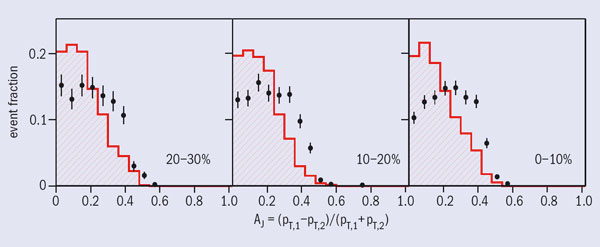
The CMS experiment has released results of a new study that sheds more light on the phenomenon known as di-jet energy imbalance, which was recently observed in lead–lead collisions at the LHC. Indeed, during the first days of the heavy-ion run in November last year both the ATLAS and CMS experiments observed collisions with the production of jets – streams of particles collimated in a small cone around a given direction. In particular, they saw collisions containing two high-energy jets (di-jets), produced more or less back to back, in which there is an unusually large imbalance in the jet energy. In other words, the energy of the jet on one side was much less than that of the jet on the other side.
This energy imbalance could result from a modification of the energy and showering properties of the partons (quarks and gluons) created in the hard scattering collision, as they traverse quark–gluon plasma that may have formed in the head-on collisions. The results on this large di-jet asymmetry, shown in figure 1 for the CMS experiment, were presented publicly by the LHC experiments at a special seminar on 2 December. The measurements were based on the detection of high-energy deposits in the calorimeters by particles emerging from the collision, which were used to characterize the jets. The momentum imbalances observed in the data are significantly larger than those predicted by the simulations, especially for collisions that have a large “centrality”, i.e. for the most violent head-on collisions.
Since then the CMS collaboration has continued its efforts to try to understand this phenomenon in more detail, in particular by also studying the tracks of charged particles produced in head-on lead–lead collisions. Such an analysis can address basic questions. For example, how does the energy redistribution in the lowest-energy jet work? Does the energy flow sideways, out of the jet cone? Or does it end up as low-energy particles that remain within the jet cone, but become difficult for the calorimeters to detect efficiently?
The new data analysis suggests that in fact both effects are present.

Based on the analysis of the charged particles correlated with the jets, CMS observes that the lowest-energy jet indeed becomes wider and the particles in the jet become softer in energy. An important question is then how the energy of the most energetic jet becomes exactly balanced in these collisions. Figure 2 shows the result of the energy-balance study, with the total missing transverse momentum projected onto the jet axis of the leading jet, as a function of the di-jet energy asymmetry, for the most central type of collisions. The contribution to the missing momentum is decomposed in contributions from particles in different intervals of particle momentum, to gain insight into what sort of particles contribute.
The top row shows Monte Carlo predictions, which do not include any physics effects that lead to asymmetries in jet energy; the bottom row shows the CMS data. The left plots sum only the momenta of particles within the jet cone – the right ones the momenta of particles outside the cones. These distributions show clearly that part of the energy of the most energetic jet becomes balanced by particles on the opposite side, outside the jet cone. They also reveal that in the data – but not in the simulation – a large fraction of the balancing momentum is carried by particles with rather low momenta.
These results provide qualitative constraints on the nature of the jet modification in lead–lead collisions and a quantitative input to models of the transport properties of the medium created in these collisions. However, this is just the proverbial tip of the iceberg towards a detailed understanding of this phenomenon and many more studies can be expected soon.








